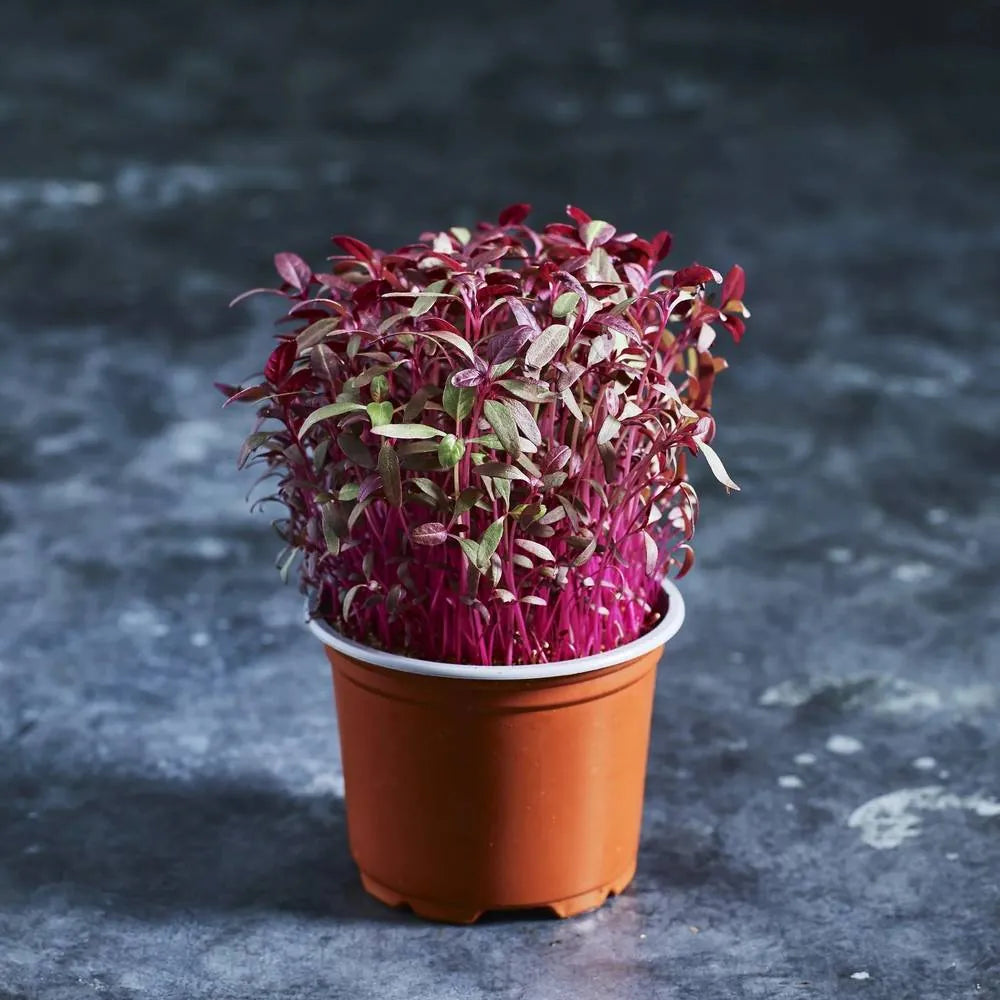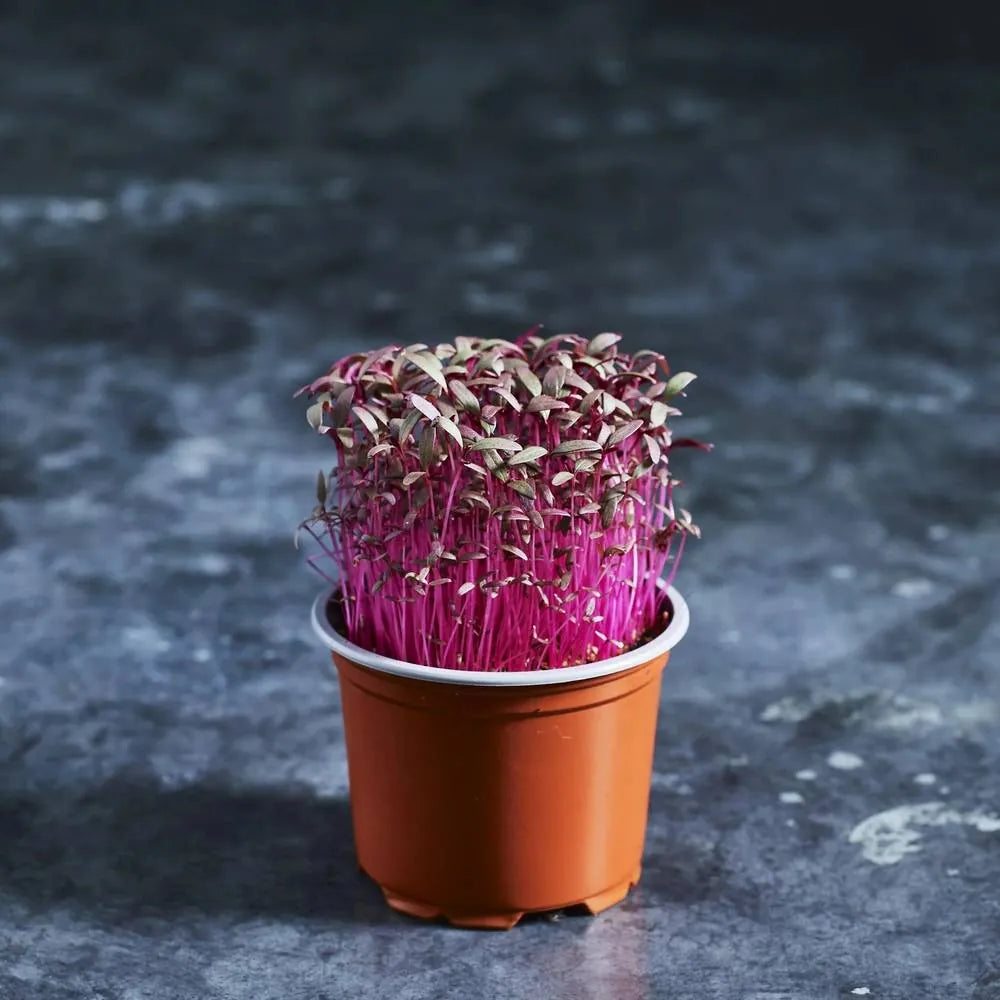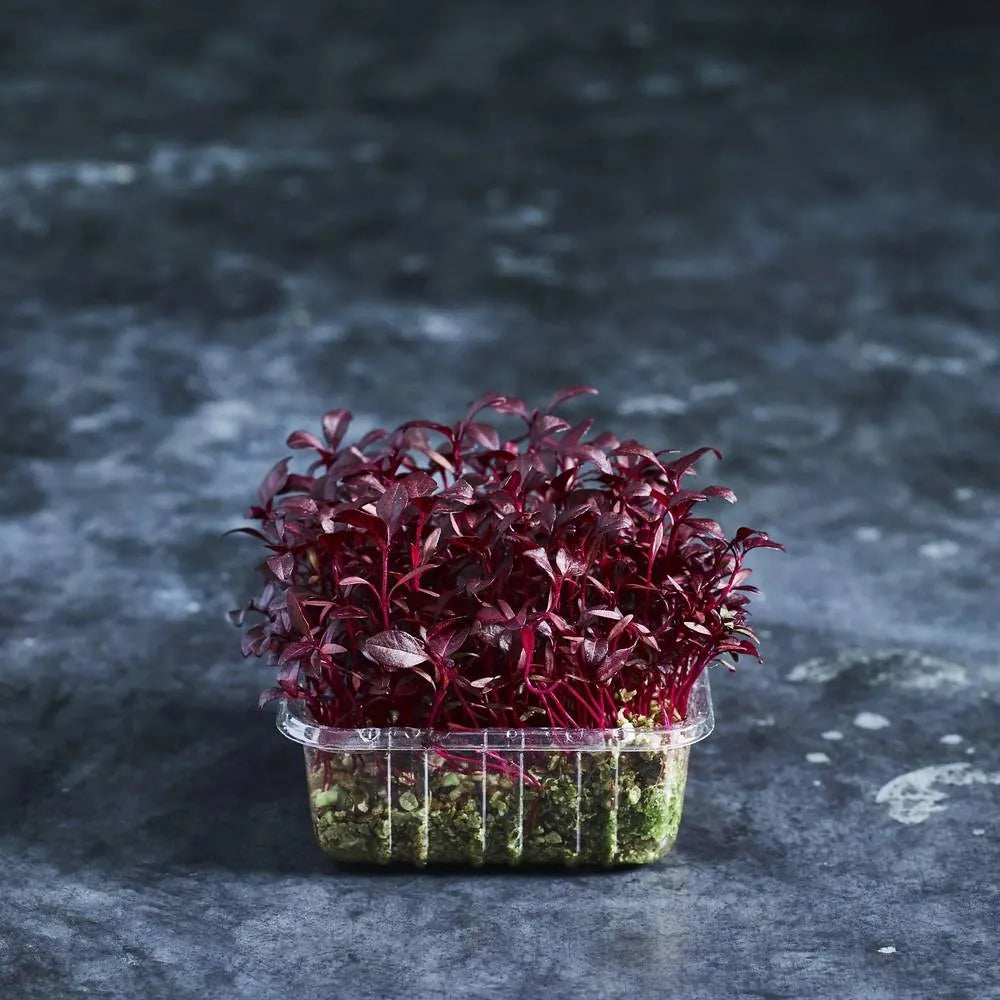Amaranth Red Garnet Seed Specifications
-
Amaranthus tricolour
- Seeds per Gram – 1,500
- Pre-soak – Not required
- Germination Rate – 93%
- Germination Temperature – 20–25 °C
- Germination Time – 2–3 days
- Days to Harvest – 8–12 days (5–7 cm tall)
- Colour – Striking pink stems with silvery-red leaves
- Flavour – Mild, earthy, slightly nutty
- Nutrients – Vitamins A, C, K and antioxidants
Amaranth Red Garnet Microgreens Are A Chef’s Favourite
Bring vibrant colour and delicate flavour to your kitchen with our premium Red Amaranth Seeds for Microgreens. A true chef’s favourite, these seeds produce striking pink stems and silvery-red leaves in less than two weeks. Loved by home growers and pros alike, amaranth microgreens add a mild, earthy-nutty lift to salads, bowls, and plated dishes.
Why Grow Red Amaranth Microgreens?
- Stunning & Delicious: Vibrant red-pink foliage with a gentle earthy, slightly nutty taste.
- Quick Turnaround: Germinates in 2–3 days, harvestable in just 8–12 days.
- Versatile: Perfect for microgreens; can also be grown on for baby leaves.
- Nutrient-Rich: Naturally high in vitamins A, C & K and antioxidants.
Culinary Uses
- Salads & Bowls: Adds colour and a mild nutty-earthy lift.
- Garnish: Perfect for fine dining plates and appetisers.
- Smoothies: Blend with broccoli or pea shoots for a nutrient-rich drink.
- Baby Leaves: Allow to grow on for larger, spinach-like leaves.
How To Grow and Harvest Amaranth Microgreens?
- Tray: Use a shallow tray with drainage holes and fill with 3–4 cm of fine seed-raising mix or coir. Level and mist to moisten evenly.
- Sowing: Spread seeds in a dense, even layer (close but not overlapping). Lightly press into the medium. Cover with a very thin layer of soil or use a humidity dome.
- Germination: Keep covered and in low light for 2–3 days at 20–25 °C. Mist daily to prevent drying out.
- Light: After germination, uncover and place under strong indirect sunlight or LED grow lights. Good light ensures compact growth and vivid red colour.
- Moisture: Mist regularly to keep the medium moist but not waterlogged. Avoid stagnant conditions that encourage fungal issues.
- Harvest: Cut just above the soil line at 5–7 cm tall (around day 8–12). Rinse gently, pat dry, and use fresh.
- Storage: Best eaten immediately. Can be kept in a sealed container in the fridge for 1–2 days.
Growing Conditions & Troubleshooting
- Light & Colour: Provide strong indirect light or multi-spectrum LEDs for compact growth and intense, deep colours that can only really be achieved through supplemental lighting.
- Temperature: Excessive cold or excessive heat can make it difficult to reliably and consistently cultivate microgreens. Controlled environments work best.
- Moisture Balance: Keep media moist but never soggy. Overwatering reduces oxygen and weakens stems.
- Damping Off: A common problem with microgreens production that causes seedlings to rot-out and die, caused by water moulds that thrive in wet conditions. To prevent it, avoid overwatering. Once seeds have sprouted, stop misting from above and switch to bottom watering. Always use sterile trays, tools, and fresh growing media for each batch of microgreens. In some cases, mould may already be present in your water source making it difficult to eliminate. Solution: Ozone-treat your water which is considered an organic practice, or convert your system to reverse osmosis water. As a last resort (not recommended), a diluted cleaning agent such as chlorine or bleach can be used with caution.
Explore more options in our Microgreens Seeds Collection or pair with Red Vein Sorrel Seeds for a vibrant contrast. Note: sorrel takes twice as long to mature as amaranth.
Live Rates – Weight & Destination Based
Shipping is automatically calculated at checkout based on your order’s weight and delivery address. We use real-time rates from Australia Post and other carriers to provide the most accurate cost.
Handling Time
Orders are packed and dispatched within 0–2 business days (Monday–Friday).
Estimated Delivery Time
Transit times depend on your location:
• Metro areas: usually 2–3 business days
• Regional/rural areas: 5–10 business days
• WA & TAS: may take longer due to state biosecurity inspections
Tracking
All orders include tracking. You’ll receive an email with your tracking link once your parcel has shipped.
Authority to Leave (ATL)
Couriers may leave parcels in a safe place if you are not home. Please provide delivery instructions at checkout if you prefer otherwise.
Pickup Option (Riverstone, NSW)
Please place your order on our website and select “Pick up” at checkout. Wait for us to contact you to confirm and arrange a pickup time. Do not come to our warehouse without an appointment — pickups are strictly by arrangement only. Allow 2–3 business days for preparation; we’ll notify you when your order is ready.
Biosecurity (WA & TAS)
Certain seeds are restricted under state biosecurity laws. Customers are responsible for ensuring products comply with local regulations. Please check with the WA Department of Primary Industries and Regional Development or the Tasmanian Department of Natural Resources and Environment before ordering.
For the full details, see our Shipping Policy.
No Change-of-Mind Returns
We do not accept returns or refunds for change-of-mind purchases.
No Exchanges
We do not accept product exchanges. All sales are final unless covered by Australian Consumer Law.
Your Rights Under Australian Consumer Law
Your ACL rights still apply. You’re entitled to a refund or replacement if your item is faulty, misdescribed, or incorrect. Please contact us within 7 days of delivery with your order number and photos if applicable. Once approved, we will provide a prepaid return label and process a refund or replacement. Refunds are issued to your original payment method within 10 business days.
90-Day Seed Germination Guarantee
If your seeds fail to germinate within 90 days of purchase, we will re-test the batch. If our test confirms poor germination, we will provide a refund or replacement. Seeds must be stored and used according to our instructions; please retain packaging or batch details if available.
For the full policy text you can also see our policy page at /policies/refund-policy.
Seed FAQ
Seeds don't expire, but their ability to sprout weakens over time. With proper storage, your seeds will remain viable for years, ensuring a high germination rate for every batch of fresh sprouts.
Key Storage Tips:
- ✅ Keep it Cool, Dry, and Dark: The best place to store seeds is in a location that's away from heat, light, and humidity.
- ✅ Use an Airtight Container: Jars or sealed bags are ideal. For extra protection against moisture, you can add a silica gel packet.
- ✅ Consider Refrigeration: For long-term storage, keeping seeds in the fridge or freezer is a great option. Just be sure to let them return to room temperature before you use them.
Sprouting Seed Viability Guide
Here's how long you can expect some of our most popular seeds to last when stored correctly:
- 1–2 Years: Mung beans, peas, lentils, and chickpeas.
- 3–4 Years: Alfalfa, radish, fenugreek, and mustard.
- 4–5 Years: Broccoli, wheatgrass, sunflower, buckwheat, and clover.
If you're unsure about older seeds, you can perform a simple germination test. Place a few seeds on a damp paper towel inside a sealed bag. Keep them moist and check the number of sprouts after 5–10 days to see if they are still viable.



